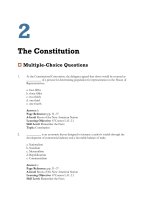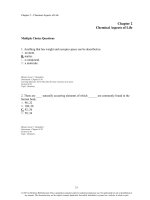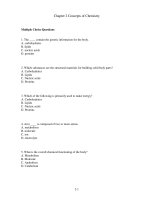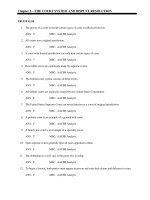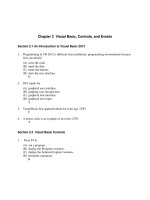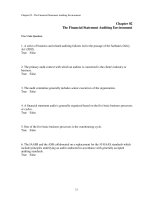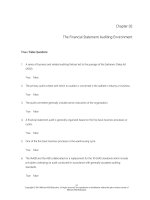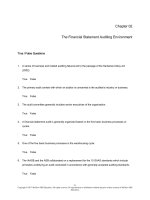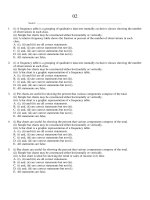Byrd and chens canadian tax principles 2012 2013 edition 1st edition byrd test bank
Bạn đang xem bản rút gọn của tài liệu. Xem và tải ngay bản đầy đủ của tài liệu tại đây (385.62 KB, 34 trang )
Chapter One Test Item File Problems
TIF PROBLEM ONE - 1
Introduction - Essay Questions
1.
The major source of federal revenues is the personal income tax. Indicate three other types of taxes that
contribute to federal revenues.
2.
What is the meaning of “person” when the term is used in the Income Tax Act?
3.
Briefly describe the procedures used in calculating provincial income taxes for individuals in provinces other
than Quebec.
4.
The Canadian income tax system is often used to achieve various economic objectives. Give three examples
that illustrate this point.
5.
Provide an example of how taxation policy can be used to influence resource allocation.
6.
The government pays a “child tax benefit” to the parents of children who are under 18 years of age. The
payments are reduced by a percentage of income in excess of a specified level. What objectives are achieved by
this benefit system?
7.
Indicate three disadvantages of a tax system that uses progressive rates.
8.
A regressive tax is one that taxes high income individuals at lower effective rates. Explain why a sales tax
levied at a flat rate of 8 percent can be regressive.
9.
Distinguish between horizontal equity and vertical equity as these terms are used in describing tax systems.
10. What are some of the factors that have led to the entrenched use of tax expenditures as opposed to program
spending?
11. While the Sections of the Income Tax Act are numbered 1 through 260, there are actually more than 260
Sections. Explain why this is the case.
12. What purposes are served by Canada’s international tax treaties?
13. List four non-legislative sources of income tax information.
14. What is the meaning of “taxation year” as the phrase is used in the Income Tax Act?
15. Under what circumstances will a person who is not resident in Canada be required to pay Canadian income
taxes?
16. What are the components of Net Income For Tax Purposes?
17. ITA 3(b) states that a taxpayer should “determine the amount, if any”, by which taxable capital gains exceeds
allowable capital losses. In this context, what is the meaning of the phrase “the amount, if any”?
18. What is the difference between tax avoidance and tax deferral?
19. What is income splitting? Under what circumstances will it provide tax benefits to an individual?
20. Contributions to a Registered Retirement Savings Plan can be deducted to reduce the taxes of an individual in
the year that they are made. However, these contributions will be subject to tax when they are withdrawn from
the plan. What type of tax planning is involved in this arrangement?
TIF PROBLEM ONE - 2
Introduction - True Or False
1.
A value added tax is a tax levied on the increase in value of a commodity or service that has been created by the
taxpayer’s stage of the production or distribution cycle.
True or False?
2.
A partnership can be a taxable entity for income tax purposes.
True or False?
3.
A partnership can be a taxable entity for GST purposes.
True or False?
4.
In general, provincial income taxes are based on a specified percentage of federal tax payable.
True or False?
5.
The federal government does not collect personal or corporate taxes for Ontario or Quebec.
True or False?
6.
A sales tax is a regressive tax even when it is applied at a single rate on all transactions.
True or False?
7.
A major advantage of progressive tax rates is that their use encourages economic growth.
True or False?
8.
Tax expenditures are less costly to administer than direct funding programs.
True or False?
9.
Part I of the Income Tax Act is the largest and most important part.
True or False?
10. The citation ITA 61(4)(b)(ii) would be read Paragraph 61, Subparagraph 4, Section b, Subsection ii.
True or False?
11. An income tax is payable for each taxation year on the Taxable Income of every person resident in Canada at
any time in the year.
True or False?
12. Any taxpayer can choose the calendar year as their taxation year.
True or False?
TIF PROBLEM ONE - 3
Introduction - Multiple Choice
Canadian Tax System
1.
Which of the following is not a taxable entity for Canadian income tax purposes?
A.
B.
C.
D.
Darklyn Ltd., a Canadian resident corporation.
Ms. Sarah Bright, a Canadian resident.
Walters and Walters, a group of CMAs operating as a partnership.
The Martin family trust.
2.
Which of the following could be required to file a GST return?
A.
B.
C.
D.
3.
Which of the following forms of taxation provides the largest component of federal government taxation
revenues:
A.
B.
C.
D.
4.
Chan’s Clothing Store (an unincorporated business)
The Chan Foundation (a registered charity)
Min Chan (an individual)
All of the above could be required to file a GST return.
Personal income tax
Corporate income tax
Goods and services tax
Employment insurance premiums
With respect to provincial income taxes, other than those assessed in Quebec, which of the following statements
is not correct?
A. Each province can apply different rates to as many brackets for individuals as it wishes.
B. The federal government collects the provincial income tax for individuals for every province except
Quebec.
C. Each province can establish its own tax credits to apply against Tax Payable for individuals.
D. Each province can establish rules for determining the Taxable Income of individuals.
Tax Policy Concepts
5.
Which of the following goals is not a current economic policy objective of the Canadian tax system?
A.
B.
C.
D.
6.
Ensure the continued provision of public goods
Redistribute income and wealth among taxpayers
Ensure fairness in the allocation of resources to different levels of government.
Economic stabilization such as stimulating the economy or creating jobs.
Which of the following can be considered an advantage of an income tax system based on progressive rates?
A.
B.
C.
D.
A progressive rate system is simpler to administer.
A progressive rate system provides greater stability in the context of changing economic conditions.
A progressive system discourages tax evasion.
A progressive system encourages greater effort on the part of individuals.
7.
Which of the following statements accurately describes a regressive tax?
A.
B.
C.
D.
8.
A tax which results in higher effective tax rates for higher income taxpayers.
A tax which results in lower effective tax rates for higher income taxpayers.
A tax in which the same effective rate applies to all levels of income.
A tax that is shifted to consumers through price increases on the goods purchased.
Which of the following statements with respect to using tax expenditures rather than program spending is not
correct?
A. It is more costly to administer tax expenditures as opposed to program spending.
B. Tax expenditures reduce the visibility of government actions.
C. Tax expenditures leave fewer decisions in the hands of the private sector, thereby providing for more
efficient allocation of resources.
D. Tax expenditures reduce the impact of progressive rates on higher income taxpayers.
9.
Which of the following would not be considered a desirable characteristic of a tax system?
A.
B.
C.
D.
Balance between sectors.
Inelasticity.
Neutrality.
Flexibility.
10. Which of the following would be considered a desirable characteristic of an effective tax system?
A.
B.
C.
D.
Inelasticity.
Lack of international competitiveness.
Simplicity.
Ambiguity.
11. “We should not have a tax system which encourages investment in particular assets or in specific areas of the
country.” This statement reflects which of the following qualitative characteristics of an effective tax system?
A.
B.
C.
D.
Neutrality.
Horizontal equity.
Simplicity.
Elasticity.
12. “Taxpayers who earn $100,000 in dividends should pay the same amount of tax as taxpayers who earn
$100,000 in capital gains.” This statement reflects which of the following qualitative characteristics of an
effective tax system?
A.
B.
C.
D.
Vertical equity.
Neutrality.
Elasticity.
Horizontal equity.
Income Tax Reference Materials
13. With respect to the structure of the Income Tax Act, which of the following statements is correct?
A. The major components of the Income Tax Act are called Divisions.
B. The current Income Tax Act has Sections numbered 1 through 260, reflecting the fact that there are 260
Sections in the Act.
C. All Parts of the Income Tax Act have Divisions.
D. All Parts of the Income Tax Act contain at least one Section.
14. Of the following publications, indicate the one that is not a legislative source.
A.
B.
C.
D.
E.
Income Tax Act.
Interpretation Bulletins.
Income Tax Application Rules.
International Tax Treaties.
Income Tax Regulations.
15. Of the following publications, indicate the one that is not published by the CRA.
A.
B.
C.
D.
Interpretation Bulletins.
Information Circulars.
Dominion Tax Cases.
Income Tax Technical News.
16. There are a number of common areas of litigation involving the CRA. Indicate which type of transaction is
least likely to be in dispute.
A.
B.
C.
D.
E.
Arm’s length versus non-arm’s length transactions.
Capital versus income transactions.
Unreported revenues from business transactions.
Establishment of fair market value.
The deductibility of farm losses against other sources of income.
17. Where would an individual find the formula for determining the prescribed rate?
A.
B.
C.
D.
The Income Tax Act.
The Income Tax Regulations.
A CRA Interpretation Bulletin.
A CRA Information Circular.
18. Which of the following statements is not correct?
A. Most major income tax changes are introduced in the annual Federal Budget.
B. A federal election can prevent passage of draft legislation.
C. Proposed changes in tax law are usually introduced to parliament in the form of a Notice of Ways and
Means Motion.
D. When there is a conflict between the Canadian Income Tax Act and an international agreement, the terms of
the Canadian Income Tax Act prevail.
Liability For Tax
19. A person is liable for income tax in Canada if they:
A.
B.
C.
D.
are a resident in Canada.
are a citizen of Canada.
have lived in Canada at anytime during the year.
All of the above are required.
20. Which of the following persons is not liable for Canadian income tax under Part I of the Income Tax Act?
A.
B.
C.
D.
Pheap Chom, an individual who has resided in Canada for the past 15 years.
Chom Incorporated, a Canadian resident corporation.
Phon Im, a resident of the United States who earns employment income in Canada.
Bunly Im, a resident of the United States who earns interest income in Canada.
21. Which of the following types of income earned by a non-resident is not subject to Canadian income tax under
Part I of the Income Tax Act?
A.
B.
C.
D.
Employment income earned in Canada
Business income earned in Canada
Rental income earned in Canada
Income from the disposition of Canadian real estate
Alternative Concepts of Income
22. Which of the following statements accurately describes the Income Tax Act view of income?
A. Net income is determined by adding revenue based on recognition at the point of sale and deducting
expenses which are determined based on generally accepted accounting principles.
B. Net income is determined by adding together several different types of income based on an ordering rule.
C. Net income is the amount paid to an employee after an employer deducts CPP, EI, income taxes and any
other source deductions from employee pay.
D. Net income is the total increase in a taxpayer’s net worth for the year.
Calculation Of Net Income For Tax Purposes
23. With respect to the calculation of Net Income For Tax Purposes, which of the following statements is not
correct?
A. Subdivision e deductions are subtracted from the total of all positive sources of income.
B. Allowable capital losses for the year can only be deducted to the extent of taxable capital gains for the year.
C. Business losses can be netted against employment income in determining the positive amounts to be
included under ITA 3(a) and 3(b).
D. Property losses can only be deducted after the subtraction of Subdivision e deductions.
24. Minjie Liu has the following sources of income and deductions:
Employment income
Interest income
Taxable dividend income
Taxable capital gain
Allowable capital loss
Subdivision e deductions
What is Minjie’s Net Income for Tax Purposes?
A.
B.
C.
D.
$47,000
$40,000
$45,000
$49,000
$35,000
5,000
7,000
5,000
12,000
2,000
25. Tanya Turek has the following sources of income and deductions:
Gross employment income
Net employment income
Business loss
Taxable capital gain
Allowable capital loss
$35,000
34,000
14,000
4,000
2,000
What is Tanya’s Net Income for Tax Purposes?
A.
B.
C.
D.
$23,000
$22,000
$36,000
$24,000
26. Fadel Ghanem has the following sources of income and deductions:
Net employment income
Property income
Business loss
Taxable capital gain
Allowable capital loss
34,000
6,000
54,000
4,000
7,000
What is Fadel’s Net Income or Loss for Tax Purposes?
A.
B.
C.
D.
$40,000 Income
Nil
$44,000 Income
$12,000 Loss
27. ITA 3(b) requires the taxpayer to “determine the amount, if any, by which taxable capital gains exceed
allowable capital losses”. The rule that is established by this phrase is:
A. That allowable capital losses in excess of taxable capital gains during a year are never deductible from
income.
B. That the current year allowable capital losses can only be deducted to the extent that there are taxable
capital gains during the current year.
C. That taxable capital gains are only included in income in a year when there are also allowable capital losses
that can be used to reduce the effect on income.
D. That unused allowable capital losses are deductible against any type of income in one of the past 3 years or
in a future year.
Net Income to Taxable Income
28. Which of the following amounts is not deducted in converting Net Income for Tax Purposes to Taxable
Income?
A.
B.
C.
D.
Losses of other years.
The lifetime capital gains deduction.
An amount related to the exercise or sale of stock options.
The excess of allowable capital losses over taxable capital gains for the year.
Tax Planning
29. Providing employees with private health care benefits involves what type of tax planning?
A.
B.
C.
D.
Tax evasion.
Tax deferral.
Income splitting.
Tax avoidance.
30. Making contributions to an RRSP always involves what type of tax planning?
A.
B.
C.
D.
Tax avoidance and tax deferral.
Tax deferral.
Tax avoidance.
Income splitting.
TIF PROBLEM ONE - 4
Introduction - Exam Exercises
Exam Exercise Concordance For Chapter 1
2012
Number
1
2011
Number
Subject
Taxable Entities (Income Taxes)
1
2
Taxable Entities (GST/HST)
2
3
Federal And Provincial Tax Payable
3
4
Federal And Provincial Tax Payable
New
5
Regressive Taxes
4
6
Regressive Taxes
7
Non-Resident Liability For Tax
5
8
Non-Resident Liability For Tax
New
9
Net Income For Tax Purposes
6
10
Net Income For Tax Purposes
New
11
Tax Planning
7
12
Tax Planning
New
13
Tax Planning
8
14
Tax Planning
New
15
Tax Planning
9
16
Tax Planning
New
New
Exam Exercise One - 1 (Taxable Entities For Income Tax Purposes)
Which of the following entities could be required to file an income tax return?
Sally Forbes (an individual)
Forbes Boutique (an unincorporated business)
Forbes and Delaney (a partnership)
The Forbes family trust (a trust)
Forbes Enterprises Ltd. (a corporation)
The Forbes Foundation (an unincorporated charity)
Exam Exercise One - 2 (Taxable Entities For GST Purposes)
Which of the following entities could be required to file a GST return?
Sally Forbes (an individual)
Forbes Boutique (an unincorporated business)
Forbes and Delaney (a partnership)
The Forbes family trust (a trust)
Forbes Enterprises Ltd. (a corporation)
The Forbes Foundation (an unincorporated charity)
Exam Exercise One - 3 (Federal And Provincial Taxes Payable)
Joan Smith has Taxable Income of $37,500. For the current year her federal tax rate is 15 percent, while the
corresponding provincial rate is 8.2 percent. Determine Ms. Smith’s combined federal and provincial tax payable,
before consideration of any available credits against Tax Payable.
Exam Exercise One - 4 (Federal And Provincial Taxes Payable)
Karla Ho has Taxable Income of $26,700. For the current year her federal tax rate is 15 percent and the
corresponding provincial rate is 10 percent. Determine Ms. Ho’s combined federal and provincial Tax Payable,
before consideration of any available credits against Tax Payable.
Exam Exercise One - 5 (Regressive Taxes)
Samantha Taylor has Taxable Income for the current year of $625,000, of which $216,000 is spent on goods and
services that are subject to Harmonized Sales Tax (HST) at a rate of 13 percent. Her sister, Martha Taylor, is a parttime student living in the same province and has Taxable Income of $12,000. During the current year, as a result of
using some of her savings, she spends $21,400 on goods and services that are all subject to HST.
Determine the effective HST rate as a percentage of the income of the two sisters.
Exam Exercise One - 6 (Regressive Taxes)
Veronica Simms has Taxable Income for the current year of $843,000. Because of her modest life style, only
$162,000 of this amount is spent on goods and services that are subject to the Harmonized Sales Tax (HST) at a rate
of 13 percent. Her sister is currently attending university on a full time basis and lives in the same city. Her
Taxable Income for the current year is $8,000. Because she is able to use savings accumulated during several years
of employment, she spends $36,000 on goods and services that are subject to HST at 13 percent.
Determine the effective HST rate as a percentage of the income of the two sisters.
Exam Exercise One - 7 (Non-Resident Liability For Tax)
Ms. Michelle Walker, a U.S. citizen, has Canadian employment income of $42,000 and U.S. employment income of
$40,000 Canadian. She lives in Seattle, Washington and is a resident of the United States for the entire year. Ms.
Walker does not believe that she is subject to taxation in Canada.
Is she correct? Explain your conclusion.
Exam Exercise One - 8 (Non-Resident Liability For Tax)
Daniel Bourne is a U.S. citizen who lives in Fargo, North Dakota. For many years, he has had a cottage on
Manitoba’s Lake Winnipeg. In recent years, however, he has made little use of this property and, given this, he has
sold the property. While there was a gain of $50,000 on the sale, Daniel assumes that he will not pay Canadian
taxes on this amount as he is a U.S. citizen.
Is he correct? Explain your conclusion.
Exam Exercise One - 9 (Net Income For Tax Purposes)
Ms. Sonia Nexus is a computer specialist with net employment income of $66,000. During the current year she has:
a taxable capital gain on the sale of land of $13,500,
an allowable capital loss on the sale of shares of $24,000,
interest income of $10,250,
net rental losses of $6,750, and
a loss from her unincorporated business of $28,000.
In addition, she makes spousal support payments of $14,000 and makes a deductible contribution to her RRSP of
$3,000 (these are Subdivision e deductions). Determine her minimum Net Income For Tax Purposes for the current
year and indicate the amount and type of any loss carry overs that are available at the end of the year. Show all of
your calculations.
Exam Exercise One - 10 (Net Income For Tax Purposes)
Harvey Nicastro has current year employment income of $45,000. In addition, he has the following additional
sources of income, gains, and losses:
A loss from an unincorporated business of $23,000.
Interest income of $4,500.
A taxable capital gain of $13,500.
An allowable capital loss of $18,200.
Spousal support paid of $24,000.
A net rental loss of $14,500.
Determine Harvey’s minimum Net Income For Tax Purposes for the current year and indicate the amount and type
of any loss carry overs that are available at the end of the year. Show all of your calculations.
Exam Exercise One - 11 (Tax Planning)
Mr. Jack Bronson makes a $5,000 contribution to his Registered Retirement Savings Plan. What type of tax
planning is involved in this transaction? Explain your conclusion.
Exam Exercise One - 12 (Tax Planning)
Ms. Sarah Bloom convinces her employer to provide her with a private drug plan in lieu of additional salary. What
type of tax planning is involved in this transaction? Explain your conclusion.
Exam Exercise One - 13 (Tax Planning)
Mr. John Lenonovitz is an unemployed poet. As Mr. Lenonovitz has no known sources of income, his wife
Natasha, a successful painter, has decided to make contributions to an RRSP in his name, rather than making
contributions to her own plan. What type of tax planning is involved in this decision? Explain your conclusion.
Exam Exercise One - 14 (Tax Planning)
Ms. Tricia Jones makes contributions to a Registered Pension Plan sponsored by her employer. What type of tax
planning is involved in this transaction? Explain your conclusion.
Exam Exercise One - 15 (Tax Planning)
Mrs. Janice Theil gives $50,000 in Canada Savings Bonds to her 27 year old, unemployed daughter. What type of
tax planning is involved in this transaction? Explain your conclusion.
Exam Exercise One - 16 (Tax Planning)
Mr. Norman Rock transfers some dividend paying shares to his 25 year son who is attending university on a full
time basis. What type of tax planning is involved in this transaction? Explain your conclusion.
TIF PROBLEM ONE - 5
Introduction - Key Term Matching
The following eight key terms are listed at the end of Chapter 1, “Introduction To Federal Taxation In Canada”:
A.
B.
C.
D.
E.
F.
G.
H.
Fiscal Period
Flat Tax System
Income Tax Regulations
Income Tax Technical News
Person
Regressive Tax System
Tax Expenditure
Value Added Tax
The following list contains ten potential definitions for the preceding key terms.
1.
A taxation year that does not exceed 53 weeks.
2.
A tax system that applies higher effective rates for individuals with lower incomes and lower effective rates for
individuals with higher incomes.
3.
An irregularly published newsletter prepared by the Income Tax Rulings Directorate.
4.
A group of over 500 individual publications which provides the CRA’s interpretation of the various laws that
they administer.
5.
A term used in the Income Tax Act to refer to taxable entities.
6.
Foregone tax revenues due to special exemptions, rate reductions, rebates, and credits that reduce the amount of
tax that would otherwise be payable.
7.
A tax based on the value added to a product at each stage of production or distribution by a particular entity.
8.
A tax on Income that is applied at the same rate to all taxpayers, without regard to the level of their income.
9.
A set of rules concerning administration and enforcement of the Income Tax Act.
10.
A tax system that applies higher effective rates for individuals with higher incomes and lower effective rates for
individuals with lower incomes.
11. None of the above definitions apply. (This answer can be used more than once.)
Required: For each of the eight key terms listed, indicate the number of the item that provides the best definition of
that term, or that none of the definitions apply. Indicate only one number for each key term. No marks will be
awarded if you indicate more than one number for any key term.
TIF PROBLEM ONE - 6
Application Of Qualitative Characteristics
The city of Elysium is located on an island in the Nirvana River. Because of its very desirable climate, it has
attracted wealthy immigrants from all over the world. These immigrants have either built palatial new homes on the
river waterfront, or moved into luxurious residences, largely in high-rise buildings in the city’s core.
In general, real estate values on the island are among the highest in the world. In order to protect their extremely
orderly environment, the residents have prevented the development of any reasonably priced housing. To help
maintain this environment the city has a large, well trained security force.
The economic activity on the island consists of financial services, haute cuisine restaurants, and retail shops which
feature high-end products from all over the world. Because of the high real estate cost, staff for these operations
must live off island and commute on a daily basis.
To accommodate residents of the island, the city operates a large heliport. This allows the residents of the island to
quickly access a nearby airport where most maintain at least one private jet.
Until recently, the only other access to the island was via a city operated ferry. This service was provided free of
charge by the city. While it was rarely used by the residents of Elysium, the staff of the various businesses on the
island relied on it for access to their jobs.
Last year, the city completed a four lane bridge to access the island. In order to finance the tremendous cost of this
project, there is a $10 toll for each trip across the bridge. To ensure that the bridge produces adequate revenues, the
city has canceled the ferry service.
Required: Evaluate the $10 toll on the basis of the qualitative characteristics of tax systems that are listed in your
text.
TIF PROBLEM ONE - 7
Net Income For Tax Purposes
The following two Cases make different assumptions with respect to the amounts of income and deductions of Ms.
Leslie Burke for the current taxation year:
Case A Ms. Burke had employment income of $17,000 and net rental income of $8,500. Her
unincorporated business lost $12,300 during this period. As the result of dispositions of capital property,
she had taxable capital gains of $17,400 and allowable capital losses of $19,200. Her Subdivision e
deductions for the year totalled $6,300. Fortunately for Ms. Burke, she won $1,000,000 in a lottery on
March 3.
Case B Ms. Burke had employment income of $42,100, interest income of $8,200, and a loss from her
unincorporated business of $51,000. As the result of dispositions of capital property, she had taxable
capital gains of $22,400 and allowable capital losses of $19,200. Her Subdivision e deductions for the year
amounted to $4,200.
Required: For both Cases, calculate Ms. Burke’s Net Income For Tax Purposes (Division B income). Indicate the
amount and type of any loss carry overs that would be available at the end of the current year.
TIF PROBLEM ONE - 8
Net Income - Two Cases
The following two Cases make different assumptions with respect to the amounts of income and deductions of Mr.
Morris Dorne for the current taxation year:
Case A Mr. Dorne had employment income of $50,000 and interest income of $12,000. His
unincorporated business lost $23,000 during this period. As the result of dispositions of capital property,
he had taxable capital gains of $95,000 and allowable capital losses of $73,000. His Subdivision e
deductions for the year totalled $8,000. He also experienced a loss of $5,000 on a rental property that he
has owned for several years.
Case B Mr. Dorne had employment income of $45,000, net rental income of $23,000, and a loss from his
unincorporated business of $51,000. As the result of dispositions of capital property, he had taxable capital
gains of $25,000 and allowable capital losses of $46,000. His Subdivision e deductions for the year
amounted to $10,500. Fortunately for Mr. Dorne, he won $560,000 in a lottery on February 24.
Required: For both Cases, calculate Mr. Dorne’s Net Income For Tax Purposes (Division B income). Indicate the
amount and type of any loss carry overs that would be available at the end of the current year.
TIF PROBLEM ONE - 9
Net Income - Four Cases
The following four Cases make different assumptions with respect to the amounts of income and deductions of
Jonathan Oakley for the current year:
Employment Income
Income (Loss) From Business
Rental Income (Loss)
Taxable Capital Gains
Allowable Capital Losses
Subdivision e Deductions
Case A
$83,000
( 22,000)
12,000
81,000
( 35,000)
( 15,000)
Case B
$92,000
( 22,000)
16,000
18,000
( 32,000)
( 12,000)
Case C
$46,000
21,000
( 42,000)
22,000
( 53,000)
( 16,000)
Case D
$57,000
16,000
( 92,000)
31,000
( 35,000)
( 17,000)
Required For each Case, calculate Mr. Oakley’s Net Income For Tax Purposes (Division B income). Indicate the
amount and type of any loss carry overs that would be available at the end of the current year.
Chapter One Test Item File Solutions
TIF Solution One - 1
1.
The other sources of federal revenues that are shown in Figure 1-1 of the text are:
Corporate income taxes.
Non-resident income taxes.
GST.
Customs and import duties.
Other excise taxes.
EI premiums.
2.
In the Income Tax Act, the term “person” can refer to an individual, a corporation, or a trust.
3.
Provincial income taxes on individuals are calculated by applying a provincial rate schedule to the same
Taxable Income figure that is used to calculate the federal income tax for individuals. Provincial credits are
then applied to the resulting figure. The provincial brackets may differ from the federal brackets. In addition,
provincial credits may be different than the federal credits.
4.
There are many examples that could be used here. The text divides them into resource allocation (e.g., public
health care), distribution effects (e.g., federal GST credit), stabilization effects (e.g., deficit reduction), and
fiscal federalism (e.g., allocations to various levels of government).
5.
Examples provided in the text are as follows:
Tax revenues are used to provide public goods and services.
Excise taxes are used to discourage the consumption of alcohol and tobacco products.
There are, of course, many other examples that could be cited.
6.
The child benefit system is designed to assist families with children. It would appear that the government is
encouraging people to have children. The fact that the benefits are reduced as income increases suggests that it
is also designed to assist lower income families care for these children.
7.
There are a number of possibilities here. They include:
Progressive rates increase the complexity of the system.
Progressive rates are unfair to individuals with highly variable income streams.
Progressive rates are unfair to single income family units.
Progressive rates lead to pressure for various types of tax concessions.
Progressive rates discourage high income individuals from making additional efforts.
Progressive rates encourage tax evasion.
8.
While the sales tax rate is the same for all individuals without regard to their income level, lower income
individuals normally spend a higher percentage of their total income. Since the sales tax is levied on the
amounts spent, this means that the sales tax paid by lower income individuals represents a larger percentage of
their income. As a consequence, they are generally considered to be regressive in nature.
9.
Horizontal equity is achieved when taxpayers in similar economic circumstances are subject to similar levels of
taxation. Vertical equity is achieved when taxpayers in different economic circumstances are subject to taxes in
a different manner.
10. The reasons that are listed in the text are as follows:
It is less costly to administer tax expenditures than it is to administer government funding programs.
More decisions are left to the private sector so that funds may be allocated more efficiently.
Tax expenditures reduce the visibility of certain government actions. This is particularly beneficial if some
social stigma is attached to the programs. For example, a child tax benefit system is more acceptable than
increasing social assistance payments.
Tax expenditures reduce the progressivity of the tax system. As many of the tax expenditures, such as tax
shelters, are more available to higher income taxpayers, they serve to reduce effective tax rates in the
higher rate brackets.
11. This situation reflects the fact that when a new Section is added, it has been more convenient to attach a decimal
designation to the new Section, as opposed to renumbering all of the Sections that follow the new Section. As
an example, over several years, the Department of Finance has added five new Sections after Section 12. They
have been numbered Section 12.1 through Section 12.5. If they had used whole numbers for these new
Sections, it would have been necessary to renumber all of the remaining Sections in the Act.
12. The purposes of these treaties are as follows:
They attempt to avoid double taxation of taxpayers who may have reason to pay taxes in more than one
jurisdiction.
They try to prevent international evasion of taxes.
13. The required four items can be selected from the following:
CRA Web Site
Interpretation Bulletins
Information Circulars
Income Tax Technical News
CRA News Releases, Tax Tips, and Fact Sheets
CRA Guides
CRA Pamphlets
Advance Income Tax Rulings
Technical Interpretations
14. For individuals and inter vivos trusts, the taxation year is equal to the calendar year. In contrast, corporations
and testamentary trusts can use a fiscal period. A fiscal period can end on any date, with the only constraint
being that it cannot exceed 53 weeks for a corporation.
15. The circumstances that would result in a non-resident person having to pay income taxes in Canada are as
follows:
The non-resident person earns employment income in Canada.
The non-resident person carried on a business in Canada.
The non-resident person has a gain on the disposal of a taxable Canadian property.
16. The components of Net Income For Tax Purposes are employment income, business and property income, net
taxable capital gains, other sources of income, and other deductions from income.
17. The phrase “the amount, if any” is used throughout the Income Tax Act to indicate that only positive amounts
should be considered. In the context of ITA 3(b), the requirement that negative amounts be ignored, in effect,
prevents the deduction of allowable capital losses in excess of taxable capital gains in the determination of Net
Income For Tax Purposes.
18. Tax avoidance is a form of tax planning in which the taxpayer, through means that are within the boundaries of
tax legislation, arranges his affairs in a manner that allows him to receive benefits without the payment of taxes.
Tax planning to achieve tax deferral involves either the delayed recognition of income, or the accelerated
recognition of deductions. The payment of tax is delayed, as opposed to permanently avoided.
19. Income splitting involves efforts to share the total income accruing to an individual with family members or
other related parties. It will only benefit a taxpayer who is in a high tax bracket in those circumstances where
there are family members or other related parties who are in lower tax brackets.
20. The basic type of tax planning that is involved in Registered Retirement Savings Plans is tax deferral — a tax
savings results from making contributions that will have to be paid back at a later point in time. There may also
be an element of avoidance in that, after retirement, an individual may be in a lower tax bracket than he was
during his working years. If this is the case, there will be an absolute reduction in taxes. (This assumes that the
basic rate structure is unchanged.)
TIF Solution One - 2
1.
True.
A value added tax is a tax levied on the increase in value of a commodity or service that has been created
by the taxpayer’s stage of the production or distribution cycle.
2.
False.
Only individuals, corporations, and trusts are taxable entities for income tax purposes.
3.
True.
Partnerships engaged in commercial activity are taxable entities for GST purposes.
4.
False.
In general, provincial taxes are based on a specified percentage of federal taxable income.
5.
False.
The federal government collects taxes for Ontario.
6.
True.
Even if the rate is the same on all transactions, it will be a higher rate on the taxable income of lower
income individuals because they spend a larger percentage of their income.
7.
False.
Progressive rates discourage both employment and investment, thereby limiting economic growth.
8.
True.
Tax expenditures are less costly to administer than direct funding programs.
9.
True.
Part I of the Income Tax Act is the largest and the most important part.
10. False.
The citation ITA 61(4)(b)(ii) would be read Section 61, Subsection 4, Paragraph b, Subparagraph ii.
11. True.
An income tax is payable for each taxation year on the Taxable Income of every person resident in Canada
at any time in the year.
12. True.
While individuals and inter vivos trusts must use a calendar taxation year, other taxpayers can choose to
use this period as their taxation year.
TIF Solution One - 3
1.
C.
Walters and Walters, a group of CMAs operating as a partnership.
2.
D.
All of the above could be required to file a GST return.
3.
A.
Personal income tax
4.
D.
Each province can establish rules for determining the Taxable Income of individuals.
5.
C.
Ensure fairness in the allocation of resources to different levels of government.
6.
B.
A progressive rate system provides greater stability in the context of changing economic
conditions.
7.
B.
A regressive tax is one which results in lower effective tax rates for higher income taxpayers.
8.
A.
It is more costly to administer tax expenditures as opposed to program spending.
9.
B.
Inelasticity.
10. C.
Simplicity.
11. A.
Neutrality.
12. D.
Horizontal equity.
13. D
All Parts of the Income Tax Act contain at least one Section.
14. B.
Interpretation Bulletins.
15. C.
Dominion Tax Cases.
16. C.
Unreported revenues from business transactions.
17. B.
The Income Tax Regulations.
18. D.
When there is a conflict between the Canadian Income Tax Act and an international agreement, the
terms of the Canadian Income Tax Act prevail.
19. A.
Are resident in Canada.
20.
D. Bunly Im, a resident of the United States who earns interest income in Canada.
21. C.
Rental income earned in Canada
22. B.
Net income is determined by adding together several different types of income which are added
together based on an ordering rule.
23. C.
Business losses can be netted against employment income in determining the positive amounts to
be included under ITA 3(a) and 3(b).
24. C.
$45,000
25. B.
$ 22,000 ($34,000 + $4,000 - $2,000 - $14,000)
26. B.
$ nil with a business loss that can be used in either the previous 3 years or in the next 20 future
years of $12,000 (34,000 + 6,000 + 4,000 – 2,000 – 54,000)
27. B.
That the current year allowable capital losses can only be deducted to the extent that there are
taxable capital gains during the current year.
28. D.
The excess of allowable capital losses over taxable capital gains for the year.
29. D.
Tax avoidance.
30. B.
Tax deferral.

